
Safety and security company Federal Signal (NYSE: FSS) missed Wall Street’s revenue expectations in Q4 CY2024, but sales rose 5.3% year on year to $472 million. On the other hand, the company’s full-year revenue guidance of $2.06 billion at the midpoint came in 2.8% above analysts’ estimates. Its non-GAAP profit of $0.87 per share was in line with analysts’ consensus estimates.
Is now the time to buy Federal Signal? Find out by accessing our full research report, it’s free.
Federal Signal (FSS) Q4 CY2024 Highlights:
- Revenue: $472 million vs analyst estimates of $483.4 million (5.3% year-on-year growth, 2.4% miss)
- Adjusted EPS: $0.87 vs analyst estimates of $0.87 (in line)
- Adjusted EBITDA: $89.3 million vs analyst estimates of $92.02 million (18.9% margin, 3% miss)
- Management’s revenue guidance for the upcoming financial year 2025 is $2.06 billion at the midpoint, beating analyst estimates by 2.8% and implying 10.7% growth (vs 8.1% in FY2024)
- Adjusted EPS guidance for the upcoming financial year 2025 is $3.75 at the midpoint, in line with analyst estimates
- Operating Margin: 14.9%, in line with the same quarter last year
- Free Cash Flow Margin: 17.4%, down from 21.1% in the same quarter last year
- Backlog: $1 billion at quarter end, down 2.4% year on year
- Market Capitalization: $5.55 billion
"Our record-setting fourth quarter performance represented a strong finish to a year in which we delivered the highest net sales and adjusted EPS in our history," commented Jennifer L. Sherman, President and Chief Executive Officer.
Company Overview
Developing sirens that warned of air raid attacks or fallout during the Cold War, Federal Signal (NYSE: FSS) provides safety and emergency equipment for government agencies, municipalities, and industrial companies.
Heavy Transportation Equipment
Heavy transportation equipment companies are investing in automated vehicles that increase efficiencies and connected machinery that collects actionable data. Some are also developing electric vehicles and mobility solutions to address customers’ concerns about carbon emissions, creating new sales opportunities. Additionally, they are increasingly offering automated equipment that increases efficiencies and connected machinery that collects actionable data. On the other hand, heavy transportation equipment companies are at the whim of economic cycles. Interest rates, for example, can greatly impact the construction and transport volumes that drive demand for these companies’ offerings.
Sales Growth
Reviewing a company’s long-term sales performance reveals insights into its quality. Any business can have short-term success, but a top-tier one grows for years. Luckily, Federal Signal’s sales grew at a decent 8.8% compounded annual growth rate over the last five years. Its growth was slightly above the average industrials company and shows its offerings resonate with customers.
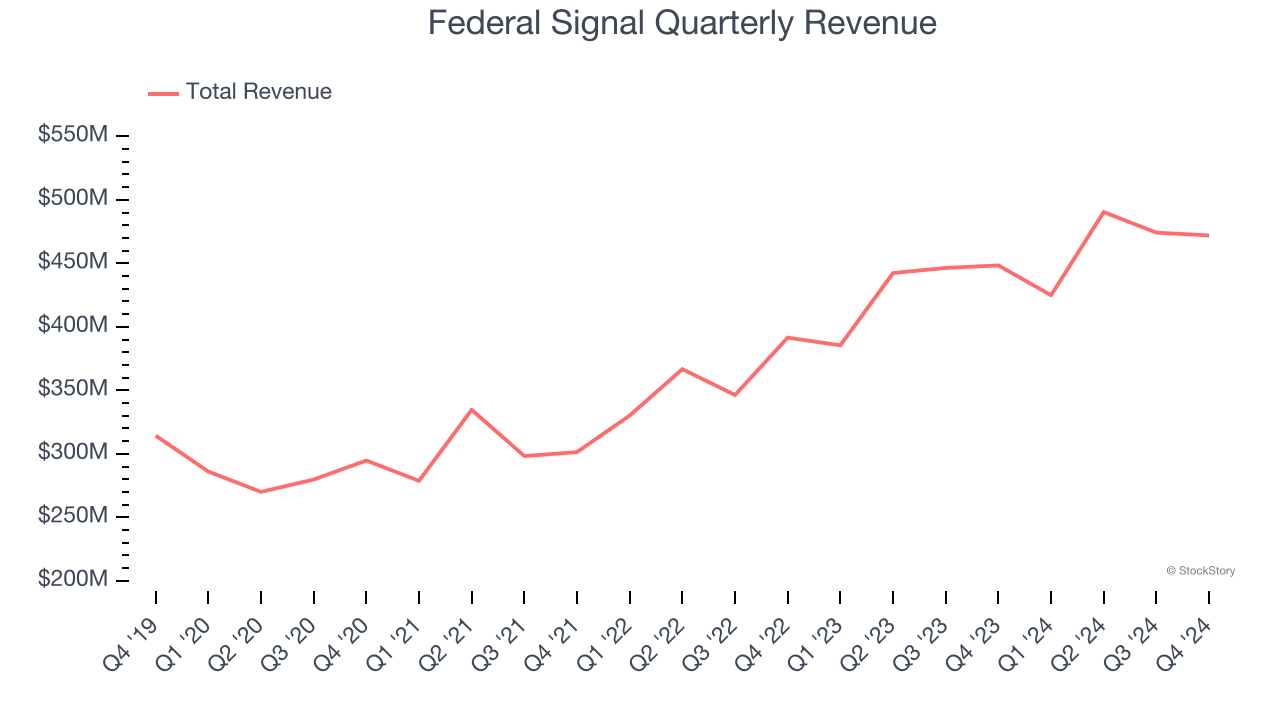
We at StockStory place the most emphasis on long-term growth, but within industrials, a half-decade historical view may miss cycles, industry trends, or a company capitalizing on catalysts such as a new contract win or a successful product line. Federal Signal’s annualized revenue growth of 13.9% over the last two years is above its five-year trend, suggesting its demand recently accelerated. 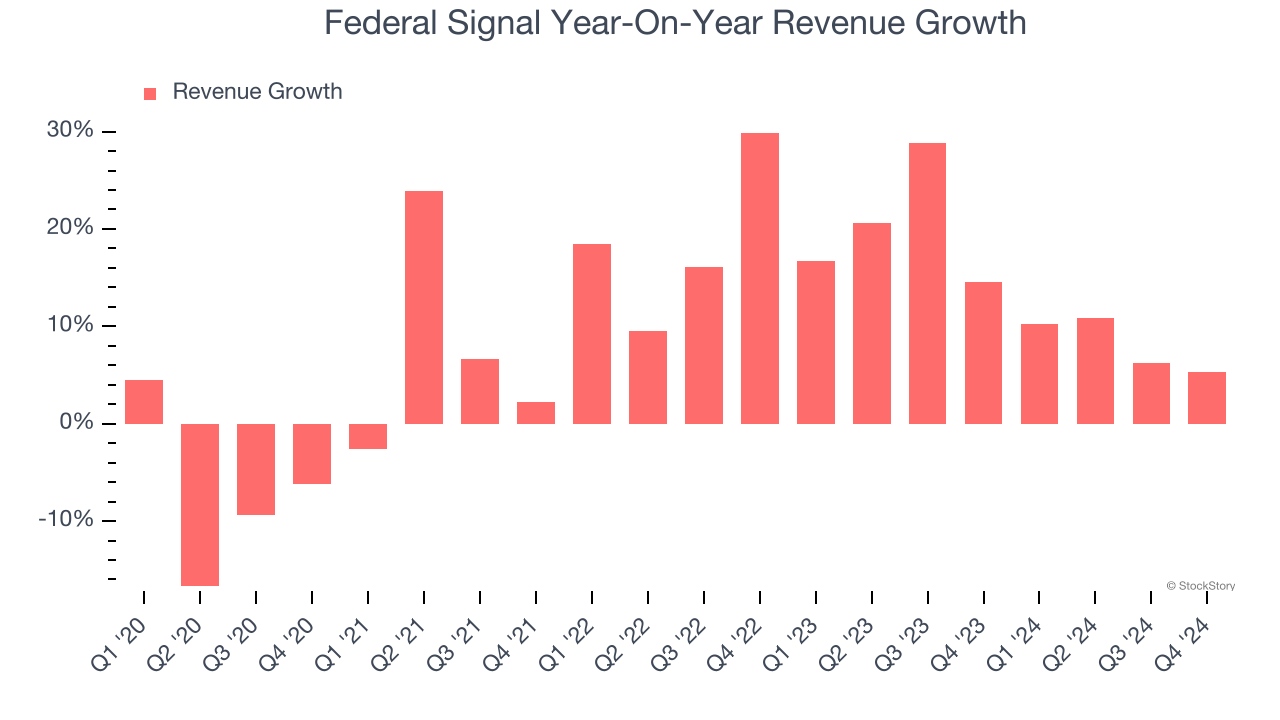
Federal Signal also reports its backlog, or the value of its outstanding orders that have not yet been executed or delivered. Federal Signal’s backlog reached $1 billion in the latest quarter and averaged 14.4% year-on-year growth over the last two years. Because this number is in line with its revenue growth, we can see the company effectively balanced its new order intake and fulfillment processes. 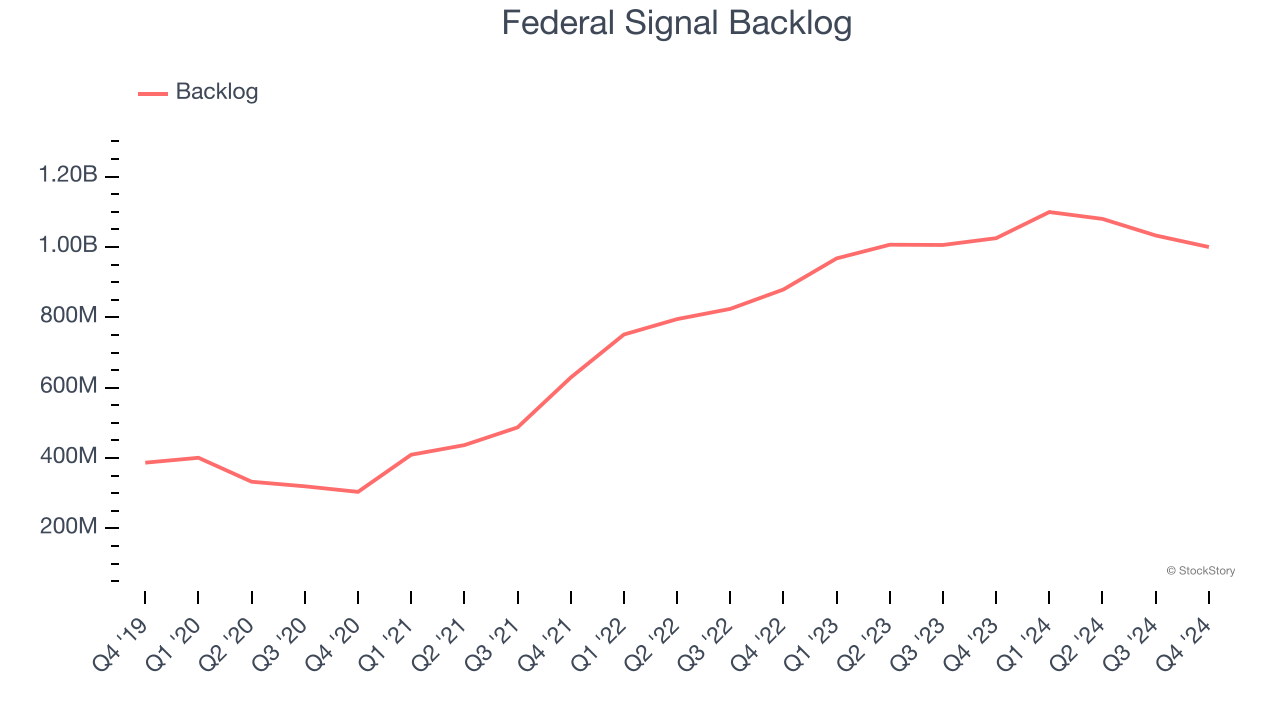
This quarter, Federal Signal’s revenue grew by 5.3% year on year to $472 million, missing Wall Street’s estimates.
Looking ahead, sell-side analysts expect revenue to grow 7.4% over the next 12 months, a deceleration versus the last two years. This projection is underwhelming and suggests its products and services will face some demand challenges. At least the company is tracking well in other measures of financial health.
Software is eating the world and there is virtually no industry left that has been untouched by it. That drives increasing demand for tools helping software developers do their jobs, whether it be monitoring critical cloud infrastructure, integrating audio and video functionality, or ensuring smooth content streaming. Click here to access a free report on our 3 favorite stocks to play this generational megatrend.
Operating Margin
Federal Signal has been an efficient company over the last five years. It was one of the more profitable businesses in the industrials sector, boasting an average operating margin of 12.6%. This result was particularly impressive because of its low gross margin, which is mostly a factor of what it sells and takes huge shifts to move meaningfully. Companies have more control over their operating margins, and it’s a show of well-managed operations if they’re high when gross margins are low.
Looking at the trend in its profitability, Federal Signal’s operating margin rose by 3.5 percentage points over the last five years, as its sales growth gave it operating leverage.
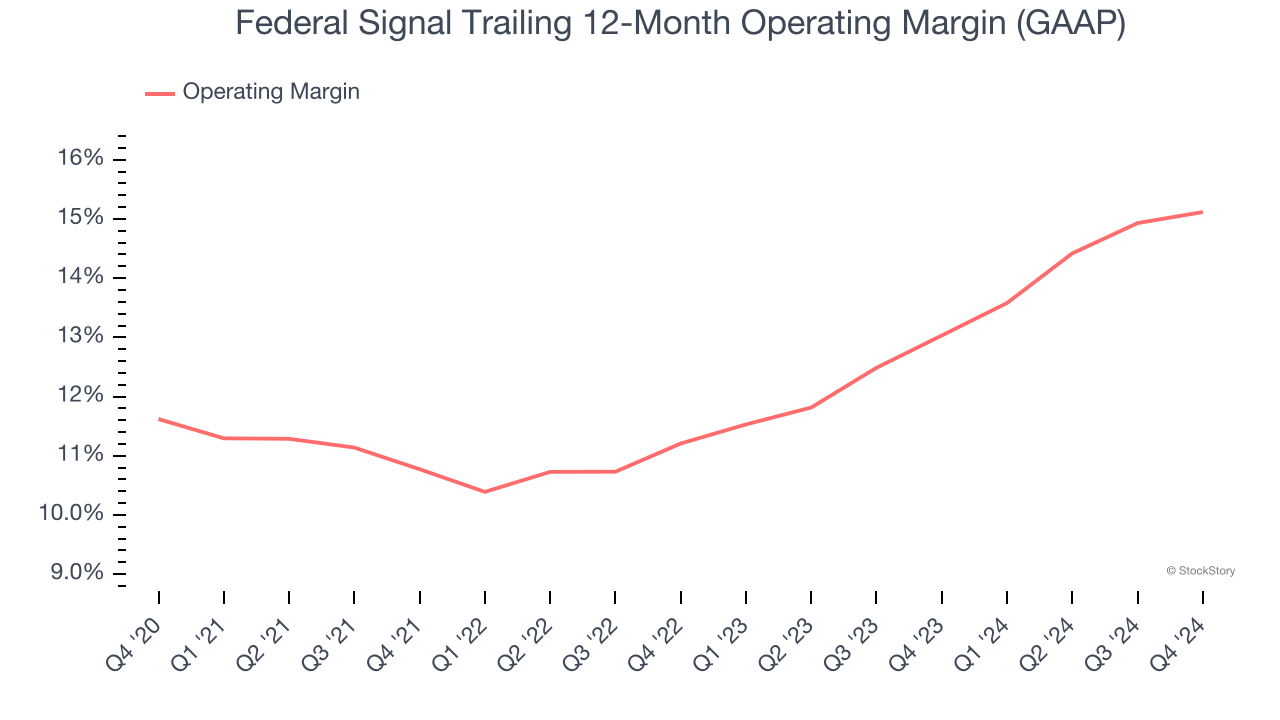
This quarter, Federal Signal generated an operating profit margin of 14.9%, in line with the same quarter last year. This indicates the company’s cost structure has recently been stable.
Earnings Per Share
Revenue trends explain a company’s historical growth, but the long-term change in earnings per share (EPS) points to the profitability of that growth – for example, a company could inflate its sales through excessive spending on advertising and promotions.
Federal Signal’s EPS grew at a remarkable 13.3% compounded annual growth rate over the last five years, higher than its 8.8% annualized revenue growth. This tells us the company became more profitable on a per-share basis as it expanded.
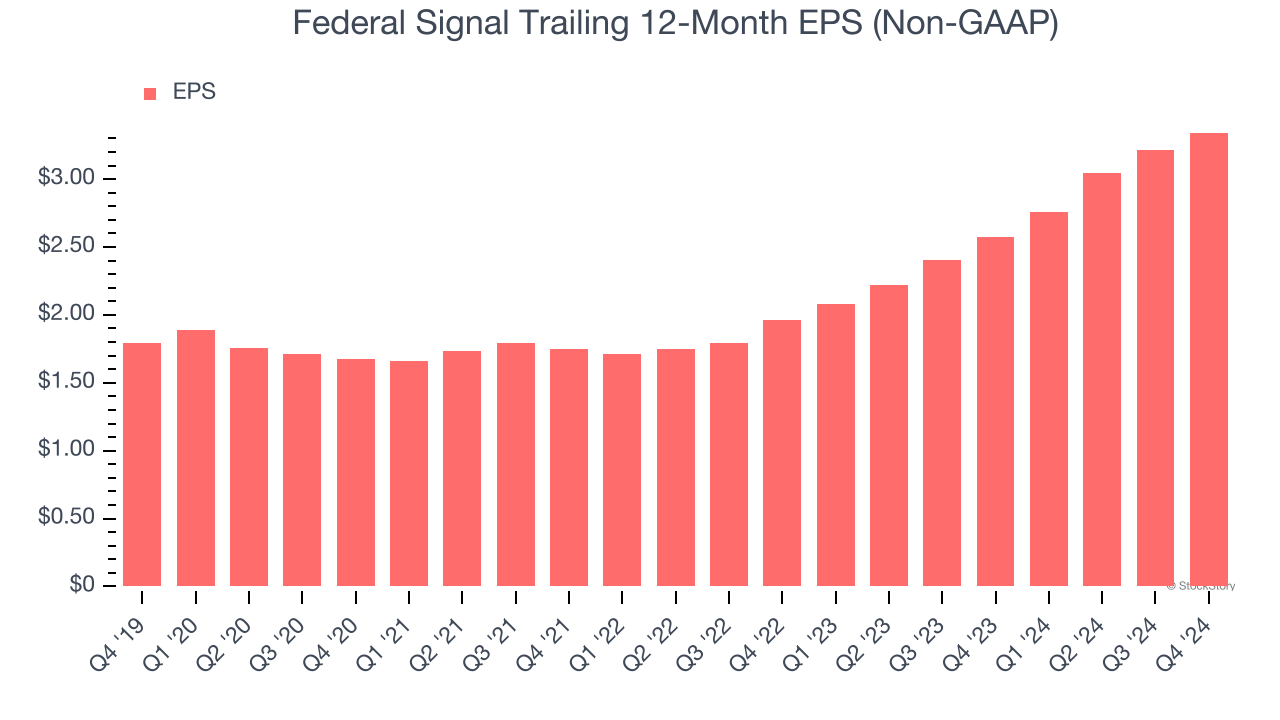
Diving into Federal Signal’s quality of earnings can give us a better understanding of its performance. As we mentioned earlier, Federal Signal’s operating margin was flat this quarter but expanded by 3.5 percentage points over the last five years. This was the most relevant factor (aside from the revenue impact) behind its higher earnings; taxes and interest expenses can also affect EPS but don’t tell us as much about a company’s fundamentals.
Like with revenue, we analyze EPS over a shorter period to see if we are missing a change in the business.
For Federal Signal, its two-year annual EPS growth of 30.5% was higher than its five-year trend. We love it when earnings growth accelerates, especially when it accelerates off an already high base.
In Q4, Federal Signal reported EPS at $0.87, up from $0.74 in the same quarter last year. This print was close to analysts’ estimates. Over the next 12 months, Wall Street expects Federal Signal’s full-year EPS of $3.34 to grow 11.8%.
Key Takeaways from Federal Signal’s Q4 Results
It was great to see Federal Signal’s full-year revenue guidance top analysts’ expectations. On the other hand, its revenue missed significantly and its backlog fell short of Wall Street’s estimates. Overall, this was a weaker quarter. The stock remained flat at $90.99 immediately after reporting.
So do we think Federal Signal is an attractive buy at the current price? When making that decision, it’s important to consider its valuation, business qualities, as well as what has happened in the latest quarter. We cover that in our actionable full research report which you can read here, it’s free.






